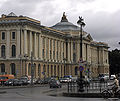Jean-Baptiste Vallin de la Mothe
Jean-Baptiste Michel Vallin de la Mothe | |
|---|---|
| Born | 1729 |
| Died | 7 May 1800 |
| Nationality | French |
| Occupation | Architect |
| Buildings | New Holland Island, Imperial Academy of Arts, Great Gostiny Dvor |
Jean-Baptiste Michel Vallin de la Mothe (1729 – 7 May 1800) was a French architect whose major career was spent in St. Petersburg, where he became court architect to Catherine II. His students were Ivan Starov and Vasily Bazhenov.[1]
Biography
Early years and education
He was born in Angoulême. Vallin de la Mothe graduated in 1750 in Paris, soon with the help of his cousin Jacques-François Blondel he entered the French Academy in Rome. According to his letters of that period, Vallin de la Mothe had a great interest to Andrea Palladio and Vincenzo Scamozzi. Beginning in 1750, Vallin de la Mothe spent two years studying at the French Academy in Rome, though not as an official pensionnaire. He graduated with distinction and was elected as a member of Academies of Arts in Florence and Bologna.[2]
On his return to Paris he was one of the architects who presented projects for Place Lous XV.[3][1]
Work in Russia
In 1759, Vallin de la Mothe accepted an offer extended through the Russian ambassador
In St. Petersburg, Vallin de la Mothe adjusted Blondel's designs for a pet project of
It is known that Vallin also redesigned interiors of the Winter Palace to Catherine II in 1762-1763.[7]
From 1761 to 1767, he pursued a number of other projects. He designed St. Petersburg's market hall,
He began, but did not complete, work on the
Return to France
In 1775 Vallin de la Mothe left Russia and came back to France. He resided in Lyon, where he designed and constructed his own house. In 1782 due to poverty and serious illness he was forced to move back to his childhood city Angoulême. The great architect died there on 7 May 1800.[11]
In France he created several urban buildings.[1] The neoclassical hôtel particulier he designed in the 1780s for Louis Thomas de Bardines survives at 79 rue de Beaulieu.[12]
Gallery
-
Arch of New Holland Island, Saint-Petersburg
-
Catholic Church of St. Catherine, Saint-Petersburg
-
Hôtel de Bardines, Angoulême
-
Imperial Academy of Arts, Saint-Petersburg
-
Saint-Petersburg
Notes
- ^ a b c d Palmer 2020, p. 303.
- ^ a b Shvidkovsky 2007, p. 232.
- ^ David Watkin, A History of Western Architecture 2005:421.
- ^ Saint Petersburg Encyclopedia Archived 2007-12-06 at the Wayback Machine.
- ^ In this project he had the assistance of Russian architects A. F. Kokorinov and Y. M. Felten. (St Petersburg Encyclopedia).
- ^ Watkin 2005, eo. loc..
- ^ Dixon 2010, p. 135-136.
- ^ George Heard Hamilton, The Art and Architecture of Russia 1983:292.
- ^ Massie 2011, p. 524.
- ^ "Yusupov Palace". The New York Times. Archived from the original on 2012-07-29. Retrieved on June 10, 2008.
- ^ Shuysky 1997, p. 73-105.
- ^ Hôtel de Bardines Archived 2007-07-08 at the Wayback Machine.
Sources
- Shuysky, V. (1997). Зрелое русское барокко и ранний классицизм [Late Baroque and Early Classicism] (in Russian). SPb: ‘Chernoye i Beloye’ publishing house. pp. 73–105.
- Palmer, Allison Lee (2020). Historical Dictionary of Neoclassical Art and Architecture. London: Rowman&Littlefield. p. 303. ISBN 9781538133590.
- Dixon, Simon (2010). Catherine the Great. Profile Books. pp. 136–137. ISBN 978-1-84765-192-1.
- Massie, Robert K. (2011). Catherine the Great: Portrait of a Woman. New York: Random House. p. 524. ISBN 9781588360441.
- Shvidkovsky, Dmitrii (2007). Russian Architecture and the West. London: Yale University Press. p. 232. ISBN 978-0-300-10912-2.
External links
 Media related to Jean-Baptiste Vallin de La Mothe at Wikimedia Commons
Media related to Jean-Baptiste Vallin de La Mothe at Wikimedia Commons- Vallin de la Mothe J.-B.M. (1729-1800), architect. at St. Petersburg Encyclopedia, ROSSPEN Publishing House





